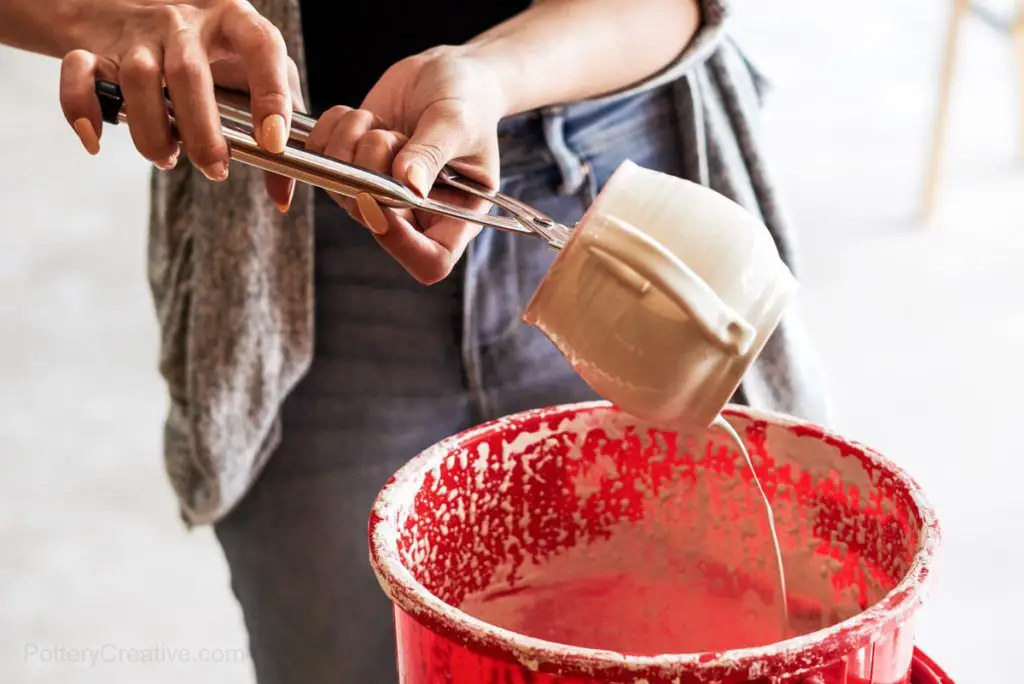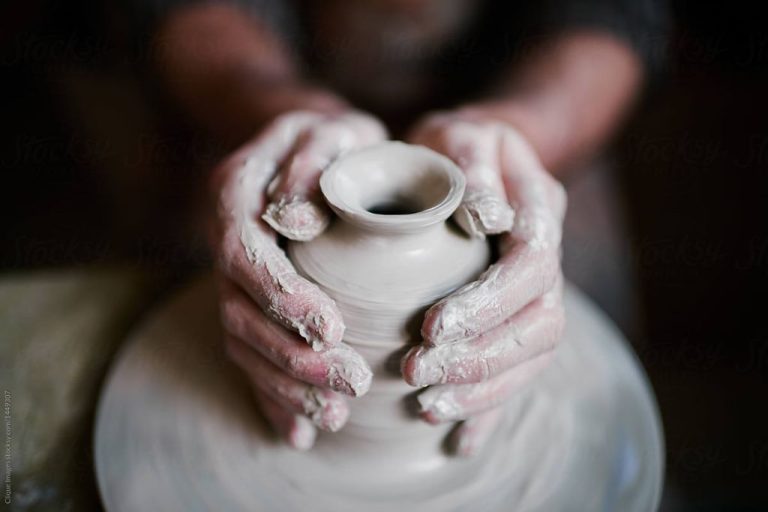What Glaze Do You Use For Pottery?
What is a Pottery Glaze?
A ceramic glaze is a glassy coating applied to pottery or ceramic ware that serves both decorative and functional purposes. According to the Merriam-Webster dictionary, a glaze is defined as “a mixture of powdered materials that often includes a premelted glass made into a slip and applied to a ceramic body by spraying or dipping and capable of fusing to a glassy coating when fired” (1). Glazes are made of finely ground minerals containing silica, alumina, and fluxes which melt when fired in a kiln, fusing to the clay body to form a glossy, impervious surface.
There are several types of glazes used in pottery:
- Underglazes – Applied to unfired clay and provide color underneath a clear glaze. Often used for hand-painting designs.
- Overglazes – Applied on top of a fired glaze and can include lusters, china paints, decals, gold leaf.
- Single-fire glazes – Melt and fuse to clay in one firing process at high temperatures (cone 6 and above).
- Low-fire glazes – Melt at lower kiln temperatures (cone 06-04) and often used for brighter colors.
Glazes serve both aesthetic and functional purposes on pottery. They provide a glassy coating that makes the ware nonporous, protecting it from stains, odors, and bacteria. Glazes allow for an infinite variety of colors, textures, and effects not possible on unglazed clay. They make surfaces water resistant and suitable for holding liquids. Glazes transform basic clay into a beautiful, durable ceramic material.
Common Glaze Ingredients
Glazes are composed of three main types of ingredients – silica, fluxes, and colorants.1 Silica provides the glass-forming structure of the glaze and comes from materials like quartz, flint, and feldspar. Flux ingredients like feldspar lower the melting temperature of silica to make glazes vitrify at kiln temperatures. Colorants like metal oxides are added to create different colors and effects.
Some common glaze ingredients include:
- Silica sources:
- Quartz – Pure silica, provides glass structure
- Flint – Silica from crushed minerals, melts well
- Feldspar – Supplies silica and flux
- Flux sources:
- Feldspar – Lowers melting temperature
- Dolomite – Magnesium carbonate flux
- Colorants:
- Cobalt oxide – Blues
- Copper oxide – Greens
- Iron oxide – Browns, yellows
Understanding the roles of these ingredients allows potters to adjust glaze recipes and properties as needed.
Glaze Types
There are several common types of glazes used in pottery:
Clear glazes are transparent and used to highlight the natural color of the clay body. They can have different surface qualities like glossy, matte, or satin. Clear glazes allow decorative techniques like brushwork or carved textures to show through.
Colored glazes have pigments added to create vibrant hues. These include glazes like blues, greens, yellows, reds, and purples. Colored glazes can be glossy or matte. They are often layered or mixed to create unique effects.
Textured glazes like crystalline glazes have additives that create visible crystals, speckles, or crackles. Crystalline glazes have tiny crystal formations when fired. Other textured glazes may create orange peel or alligator skin type textures.
For more information, see these sources:
[How To Choose Pottery Glaze](https://www.soulceramics.com/pages/how-to-choose-pottery-glaze)
[Choosing a Pottery Glaze – A Beginners Guide to Glazes](https://thepotterywheel.com/choosing-a-pottery-glaze/)
How Glazes Work
Glazes work by forming a glassy coating on the clay body through a process called vitrification. As the glaze melts during firing, the silica and flux ingredients fuse together to form glass. The alumina acts as a stabilizer to prevent the glaze from becoming too fluid and running off the pottery piece.
When applied to an absorbent clay body, the glaze interacts with the clay through the process of ion exchange. As the glaze melts, ions from the glaze penetrate into the clay body, while ions from the clay body diffuse into the glaze. This results in the glaze “biting” or adhering tightly to the clay.
Several factors affect how a glaze melts, flows, and forms the glassy coating during firing. Firing temperature is critical – the glaze must mature within the kiln’s temperature range to vitrify properly. Glaze thickness also matters, as thicker glazes tend to run more. Ingredients like alumina modify the glaze’s melting behavior. The makeup of the clay body beneath the glaze further influences the final result.
By understanding how glazes interact with clay at a molecular level during firing, potters can learn to formulate, apply, and fire glazes to achieve the desired decorative effects on their finished ceramic ware.
Applying Glazes
There are several techniques for applying glaze to pottery pieces before firing them in a kiln. The most common glaze application methods include:
Brushing
Using a brush to apply glaze allows for a lot of control and is good for detailed decoration. Different brushes like soft bristle brushes, hake brushes, and sumi brushes can create different effects. Brushing works for applying overall coats of glaze as well as making marks and details.
Dipping
Dipping the pottery directly into a bucket or container of liquid glaze fully submerges the piece and ensures an even coating. This technique works best for pieces without intricate surface texture or decorations that could trap air bubbles. Carefully drain excess glaze off the piece after dipping.

Pouring
Pouring liquid glaze directly onto the surface of the pottery can create interesting drips and pooling effects. Tilting the piece allows the glaze to run off evenly. Pouring works well for glaze techniques like crawling when certain areas are left unglazed.
Spraying
Spraying glaze through an airbrush tool or spray gun allows very even, smooth applications. Spraying on multiple thin layers can create interesting interactions and effects. Masking off areas before spraying enables sharp edges in the glaze surface.(1)
Food Safe Glazes
When creating pottery intended for food use, it’s crucial to use glazes that are food safe. Lead glazes are toxic and should never be used on items for food. Instead, opt for lead-free glazes made with FDA approved materials.
According to Penguin Pottery, “Our glazes are lead-free, non-toxic and food safe (when properly fired and tested).” Lead-free glazes avoid hazardous materials like lead, cadmium, or other heavy metals that can leach into food (Penguin Pottery).
To create food safe pottery, use glazes specially formulated to be non-toxic and lead-free. Test all glazes after firing to ensure they are fully matured and sealed. Avoid any glazes with crazing, pitting, or other flaws that could allow food to touch bare clay. Additionally, do not use any special finishes or decorations that are not explicitly labeled as food safe (Soul Ceramics).
With properly fired lead-free glazes made from food safe materials, potters can create functional, safe pottery for everyday use.
Troubleshooting Glazes
Glazes can develop a variety of issues during the firing process that result in undesirable effects. Being able to identify and troubleshoot common glaze problems is an important skill for potters.
Crazing
Crazing occurs when the glaze contracts more than the clay body during cooling, causing a network of fine cracks in the surface. It looks like a spiderweb of hairline cracks across the glazed surface. Crazing is often caused by a mismatch between the clay and glaze compositions or firing temperature. To fix it, try using a clay body and glaze with similar expansion rates and optimize the kiln’s cooling cycle (Source).
Crawling
Crawling happens when the glaze melts and retracts off areas of the clay surface during firing. This leaves behind bare patches without glaze coverage. It’s typically caused by the glaze being too fluid or by contaminants on the clay surface. Solving it may require adjusting the glaze recipe, firing schedule, or improving clay surface preparation (Source).
Crazing
Blistering occurs when bubbles of steam or gases get trapped between the glaze and clay body during firing. It creates dome-like bumps across the surface. Blistering is often due to the glaze layer being too thick, inadequate drying time, or impurities in the clay or glaze. Try thinning glaze coats, allowing adequate drying between coats, and removing contaminants from clay and glazes (Source).
Decorative Glaze Techniques
There are many decorative techniques that can be used to create beautiful effects with glazes on pottery. Some popular techniques include:
Inlaying
Inlaying involves carving lines or designs into leather-hard clay then filling the recessed areas with a contrasting colored glaze or slip. The glaze stays inside the carved lines after firing, creating an inlaid design (Ceramic Arts Network).
Engraving
Engraving is done by incising designs into bisqueware or glazed surfaces using sharp tools. The engraved lines provide contrast by revealing the bare or differently colored clay underneath the glaze.
Feathering
Feathering is a technique where two contrasting glazes are blended softly into one another with a brush, sponge, or finger. This creates feather-like patterns and textures.
Using Resists and Masks
Resists are materials like wax, latex, or glaze that are applied to block glaze in specific areas. When fired, the resist burns away leaving the bare clay exposed. Masks made from paper or tape can be used to shield areas from glaze as well. The resist or mask preserves the original clay color creating a decorative effect.
Glaze Recipes
Glaze recipes allow you to recreate tried and true combinations of ingredients that result in beautiful pottery glazes. Here are some sample recipes to get you started:
Cone 6 Clear Glaze
This simple clear glaze works well at cone 6 temperatures (source):
- 25% Gerstley Borate
- 25% Silica
- 50% Frit 3124
Blue Celadon Glaze
This recipe for a classic blue celadon glaze is lovely on porcelain (source):
- 25% Nepheline Syenite
- 37.5% Frit 3249
- 12.5% Dolomite
- 12.5% Silica
- 12.5% Kaolin
- 3% Cobalt Carbonate
Speckled Orange Glaze
This glaze features a warm orange color with darker speckles (source):
- 10% Red Iron Oxide
- 10% Yellow Iron Oxide
- 10% Manganese Dioxide
- 35% Calcium Borate
- 35% Sodium Feldspar
Glazing Safety
When working with ceramic glazes, it’s important to follow proper safety precautions. Glazes contain potentially hazardous materials that can pose health risks if handled improperly. Proper studio ventilation and handling precautions are key to staying safe.
Adequate ventilation should be used when working with glazes, especially in the glazing area. Glazes contain silica dust which can be harmful if inhaled over time. Operating a ventilated spray booth or fume hood helps capture airborne silica and prevents exposure. General studio ventilation like open windows, exhaust fans, and air filtration systems also help improve air quality and circulation.
When handling glaze materials, precautions should be taken as well. Wearing a N95 face mask prevents breathing in silica dust when mixing dry glaze materials. Gloves protect hands from irritation that some glaze ingredients can cause. An apron or smock keeps clothing free of splatters when dipping or spraying glaze on ware. Always wash hands thoroughly after glazing. Avoid eating, drinking, or smoking when in the glazing area, and keep food preparation utensils separate. Following proper handling procedures reduces contact with hazardous materials.
By implementing proper ventilation and safe handling practices in the studio, ceramic artists can work with glazes while minimizing exposure risks. Taking basic precautions for health and safety allows the creative process to continue safely.
Sources:
https://www.southtexascollege.edu/academics/visual-arts/safety/ceramics.html


